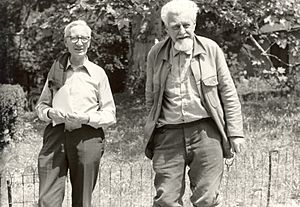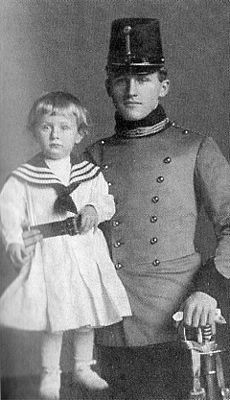Konrad Lorenz facts for kids
Quick facts for kids
Konrad Lorenz
|
|
|---|---|

Lorenz (right) with Niko Tinbergen in 1978
|
|
| Born | 7 November 7 1903 |
| Died | February 27, 1989 (aged 85) |
| Nationality | Austrian |
| Awards | Nobel Prize in Physiology or Medicine (1973) |
| Scientific career | |
| Fields | Ethology |
Konrad Zacharias Lorenz (born November 7, 1903 – died February 27, 1989) was an Austrian zoologist and ethologist. An ethologist is a scientist who studies animal behavior. He is known as one of the main founders of modern ethology.
In 1973, he won the Nobel Prize in Physiology or Medicine. He shared this important award with Nikolaas Tinbergen and Karl von Frisch.
Lorenz spent a lot of time studying geese. He became famous for his work on something called imprinting. This is a special way some young birds, like geese, learn to bond with the first moving thing they see after hatching. They often think this first moving object is their parent.
He wrote many popular books, including King Solomon's Ring, On Aggression, and Man Meets Dog. His last book, "Here I Am – Where Are You?", was about his studies of greylag geese.
In an essay he wrote for the Nobel Prize, Lorenz said his parents helped him a lot. He also mentioned that a children's book, The Wonderful Adventures of Nils by Selma Lagerlof, made him interested in wild geese when he was young.
Contents
Konrad Lorenz's Early Life
Konrad Lorenz was born in Vienna, Austria. His father, Adolf Lorenz, was a very successful surgeon. His mother, Emma, was also a doctor and helped his father. The family lived in a big house in Altenberg and also had an apartment in Vienna.
From a young age, Konrad loved animals. His parents were very supportive of his interest. He started collecting many different animals, from fish to monkeys, even while he was still a student. He wrote about these experiences in his book King Solomon's Ring.
Education and Discoveries
Lorenz started studying medicine at Columbia University in 1922, but he soon returned to the University of Vienna. He became a medical doctor in 1928. Later, he also earned a PhD in zoology in 1933.
In 1936, Lorenz met another important ethologist, Nikolaas Tinbergen. They became good friends and worked together to study geese. They observed how wild geese, domestic geese, and even mixed-breed geese behaved.
War Years and Return to Science
During World War II, Lorenz joined the German army in 1941 as a medic. In 1944, he was sent to the Eastern Front, where he was captured. He spent four years as a prisoner of war in the Soviet Union until 1948. While he was a prisoner, he continued to work as a medic and even learned some Russian. He was allowed to keep a book he was writing and his pet starling when he returned home. This book later became Behind the Mirror.
After the war, Lorenz continued his scientific work. In 1950, the Max Planck Society opened an institute for animal behavior studies in Germany, and Lorenz worked there. In 1958, he moved to the Max Planck Institute for Behavioral Physiology in Seewiesen.
Nobel Prize and Later Life
In 1973, Konrad Lorenz, along with Nikolaas Tinbergen and Karl von Frisch, received the Nobel Prize in Physiology or Medicine. They were honored for their discoveries about how animals behave, both alone and in groups.
Lorenz retired from the Max Planck Institute in 1973. However, he kept researching and writing from his home in Austria until he passed away on February 27, 1989. He was a friend of other famous scientists like Julian Huxley and Karl Popper.
Personal Life
Konrad Lorenz married his childhood friend, Margarethe Gebhardt, who was a gynecologist. They had a son and two daughters. He lived in his family's large home, which was a beautiful old mansion.
Important Books
Lorenz wrote many books that helped people understand animal behavior better. Some of his most famous books include:
- King Solomon's Ring (1949)
- Man Meets Dog (1950)
- On Aggression (1966)
- Behind the Mirror: A Search for a Natural History of Human Knowledge (1973)
- The Year of the Greylag Goose (1979)
Images for kids
See also
 In Spanish: Konrad Lorenz para niños
In Spanish: Konrad Lorenz para niños






